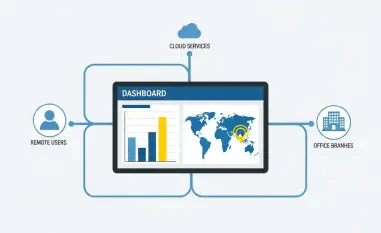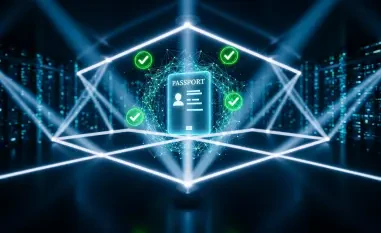In an era where cyber threats have become alarmingly sophisticated and workforces are more distributed than ever before, the urgency for cutting-edge cybersecurity measures has reached unprecedented levels, demanding innovative solutions to protect digital assets. Traditional security approaches, such as firewalls and Virtual Private Networks (VPNs), often prove inadequate in a digital landscape where network boundaries are virtually nonexistent. Enter Zero Trust Network Access (ZTNA), a transformative framework that operates on the uncompromising principle of “never trust, always verify.” This innovative approach is reshaping how organizations safeguard their digital assets by rejecting the outdated assumption that anyone inside or outside the network can be inherently trusted. As remote work, cloud adoption, and personal device usage continue to blur conventional security perimeters, ZTNA emerges as a critical solution to address escalating risks. By prioritizing identity verification, minimal access privileges, and continuous monitoring, it offers a robust defense tailored to the complexities of modern, hybrid work environments.
Unpacking the Foundations of ZTNA
At its core, ZTNA redefines network security through a set of fundamental principles designed to counter today’s dynamic threats. The framework centers on identity-centric security, ensuring that every access request undergoes stringent verification, often through multi-factor authentication (MFA). This means that even if credentials are stolen, unauthorized entry remains nearly impossible without additional validation. Unlike traditional models that grant broad access once inside the network, ZTNA insists on scrutinizing every user and device, regardless of their location. This shift eliminates the dangerous assumption of implicit trust, addressing vulnerabilities exploited by attackers through lateral movement. By focusing on who is accessing what and under what conditions, ZTNA builds a security posture that adapts to the fluid nature of modern IT environments, making it a vital tool for organizations facing sophisticated cyber risks in a perimeter-less world.
Another key aspect of ZTNA is the integration of least privilege and continuous verification to fortify defenses. The principle of least privilege ensures users receive only the specific permissions required for their roles, drastically reducing the potential impact of a breach by limiting access to critical systems. Meanwhile, continuous verification goes beyond static access approvals, dynamically evaluating trust based on real-time factors such as user behavior, device health, or contextual risks. If anomalies are detected, access can be revoked instantly, preventing threats from escalating. Additionally, application-level segmentation isolates resources, ensuring a compromise in one area doesn’t cascade across the entire network. These mechanisms collectively create a layered security approach that not only mitigates risks but also aligns with the evolving needs of distributed workforces, providing a proactive rather than reactive stance against cyber threats.
Advantages That Set ZTNA Apart
One of the most compelling benefits of ZTNA is its ability to significantly reduce the attack surface in ways traditional solutions cannot match. By concealing applications from the public internet and granting access only to authenticated users, it becomes far more challenging for cybercriminals to identify and exploit vulnerabilities. This stands in stark contrast to VPNs, which often provide overly expansive access, leaving organizations susceptible to lateral attacks once a breach occurs. ZTNA’s granular, application-specific control minimizes exposure, ensuring that even if an attacker gains entry, their ability to navigate the network is severely restricted. This targeted approach addresses a critical flaw in outdated security models, offering a shield against the increasingly cunning tactics employed by modern hackers and positioning ZTNA as an indispensable asset in today’s threat landscape.
Beyond its robust security features, ZTNA delivers substantial operational and experiential benefits, particularly for remote and hybrid workforces. Unlike VPNs, which can bog down connections and frustrate users with cumbersome logins, ZTNA provides seamless, secure access to applications from any device or location. This not only boosts productivity but also enhances user satisfaction by eliminating unnecessary friction. For IT teams, the centralized policy management inherent in ZTNA simplifies the oversight of access controls, allowing administrators to focus on application-level permissions rather than wrestling with intricate network configurations. Furthermore, compliance with stringent regulations like GDPR and HIPAA is streamlined through detailed logging and strict access protocols, offering transparency and accountability. These combined advantages make ZTNA a practical solution that balances security with efficiency, catering to the dual needs of protection and usability in contemporary organizational settings.
Diverse Applications Across Sectors
ZTNA’s adaptability is vividly demonstrated through its wide-ranging applications across various industries, each with unique security demands. In the financial sector, it plays a pivotal role in protecting sensitive transactions and customer data from fraud and unauthorized access, ensuring trust in digital banking and investment platforms. Healthcare organizations leverage ZTNA to secure telehealth systems and connected medical devices, safeguarding patient information against breaches that could have dire consequences. Educational institutions benefit by providing safe access to online learning platforms for students and faculty, maintaining data integrity in virtual classrooms. Meanwhile, manufacturers rely on ZTNA to shield IoT devices and industrial control systems from cyberattacks that could disrupt operations. These examples underscore how ZTNA can be tailored to meet sector-specific challenges, proving its versatility as a cornerstone of modern cybersecurity strategies.
The impact of ZTNA extends beyond individual sectors, fostering a broader culture of security in critical areas of operation. For instance, in industries handling vast amounts of personal data, such as retail or government services, ZTNA ensures that access to customer or citizen information is tightly controlled, reducing the risk of costly data leaks. Its ability to integrate with existing identity management systems further enhances its applicability, allowing organizations to build on current infrastructure without starting from scratch. This flexibility is particularly valuable in environments where downtime or disruption must be minimized, as ZTNA can be deployed incrementally to address the most pressing vulnerabilities first. By catering to such a diverse array of needs, from protecting intellectual property in tech firms to securing supply chain networks in logistics, ZTNA establishes itself as a universal framework capable of evolving with industry-specific threats and requirements.
Navigating the Hurdles of ZTNA Implementation
While ZTNA offers undeniable benefits, its adoption is not without significant challenges that organizations must carefully navigate. One prominent obstacle is integrating ZTNA with legacy infrastructure, particularly in industries reliant on older systems that were not designed for modern security protocols. This integration often demands substantial time and financial investment to update or replace outdated technology, a burden that can be especially heavy for smaller entities with limited budgets. The complexity of aligning ZTNA with existing workflows can also lead to operational disruptions if not managed with precision, requiring detailed planning and expertise. Addressing this issue necessitates a phased approach, prioritizing critical systems and ensuring compatibility through thorough testing, to avoid compromising security during the transition to a Zero Trust model.
Another challenge lies in user adaptation and organizational dynamics surrounding ZTNA deployment. Frequent verification processes, while essential for security, can be perceived as intrusive or inconvenient by employees accustomed to the relative simplicity of VPNs, leading to resistance or non-compliance. This friction highlights a broader tension in cybersecurity between robust protection and user-friendliness, a balance ZTNA must strike to gain widespread acceptance. Additionally, the risk of vendor lock-in looms large, as dependence on a single provider’s ecosystem may limit flexibility and increase costs over time. To mitigate these issues, organizations should focus on clear communication about the long-term benefits of ZTNA, alongside training programs to ease the transition. Opting for interoperable solutions and maintaining partnerships with multiple vendors can also help preserve strategic autonomy, ensuring that the adoption of ZTNA enhances rather than restricts operational freedom.
Emerging Horizons for ZTNA Development
As cybersecurity threats continue to evolve, ZTNA is poised to advance alongside cutting-edge technologies that promise to elevate its effectiveness. The incorporation of artificial intelligence (AI) and machine learning (ML) into ZTNA frameworks stands out as a game-changer, enabling real-time policy adjustments based on user behavior patterns and emerging threat indicators. This predictive capability allows organizations to stay ahead of potential breaches by identifying anomalies before they escalate into full-scale attacks. Such dynamic adaptability is crucial in an era where cybercriminals constantly refine their tactics, and it positions ZTNA as a forward-thinking solution. The potential for AI-driven insights to enhance decision-making for IT teams further underscores the transformative impact of these technologies on the Zero Trust model, paving the way for smarter, more responsive security measures.
Equally promising is the convergence of ZTNA with Secure Access Service Edge (SASE) frameworks, which unify networking and security into streamlined, cloud-delivered services. This integration addresses the growing complexity faced by IT departments, particularly in organizations with limited resources, by simplifying the management of distributed environments. Another significant trend is the increasing accessibility of ZTNA for small and medium-sized businesses (SMBs), driven by the emergence of cost-effective, scalable solutions that democratize enterprise-grade security. Industry forecasts, such as those from Gartner, indicate that ZTNA will become a standard requirement for cloud-native enterprises, reflecting a broader shift away from outdated models like VPNs. This trajectory suggests that ZTNA will continue to solidify its place as a foundational element of cybersecurity, evolving to meet the needs of diverse organizations while addressing the relentless pace of digital transformation and cyber threats.
Reflecting on ZTNA’s Transformative Impact
Looking back, the adoption of ZTNA marked a pivotal moment in the evolution of cybersecurity, offering a robust response to the limitations of traditional perimeter-based defenses. Its emphasis on identity verification, least privilege, and continuous monitoring provided a much-needed shield against the sophisticated threats that characterized the digital landscape. The framework’s ability to adapt to remote work and hybrid environments proved instrumental in securing distributed workforces, while its operational benefits streamlined IT management and improved user experiences. Challenges such as legacy integration and user resistance were navigated through strategic planning and phased implementations, demonstrating that obstacles could be overcome with foresight. Moving forward, organizations should prioritize investing in scalable ZTNA solutions, integrating AI-driven insights, and exploring SASE convergence to stay ahead of emerging risks. By building on these past achievements, the path ahead involves fostering a proactive security culture that anticipates rather than reacts to the next wave of cyber challenges.













